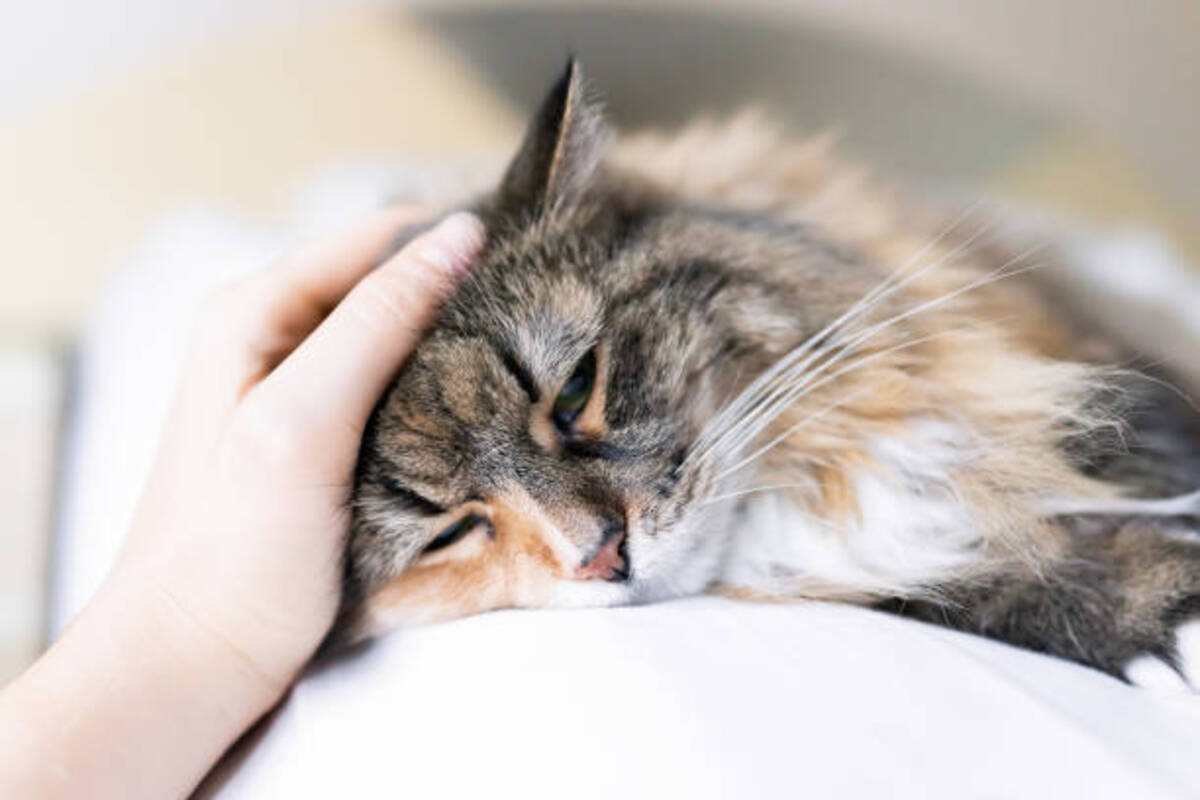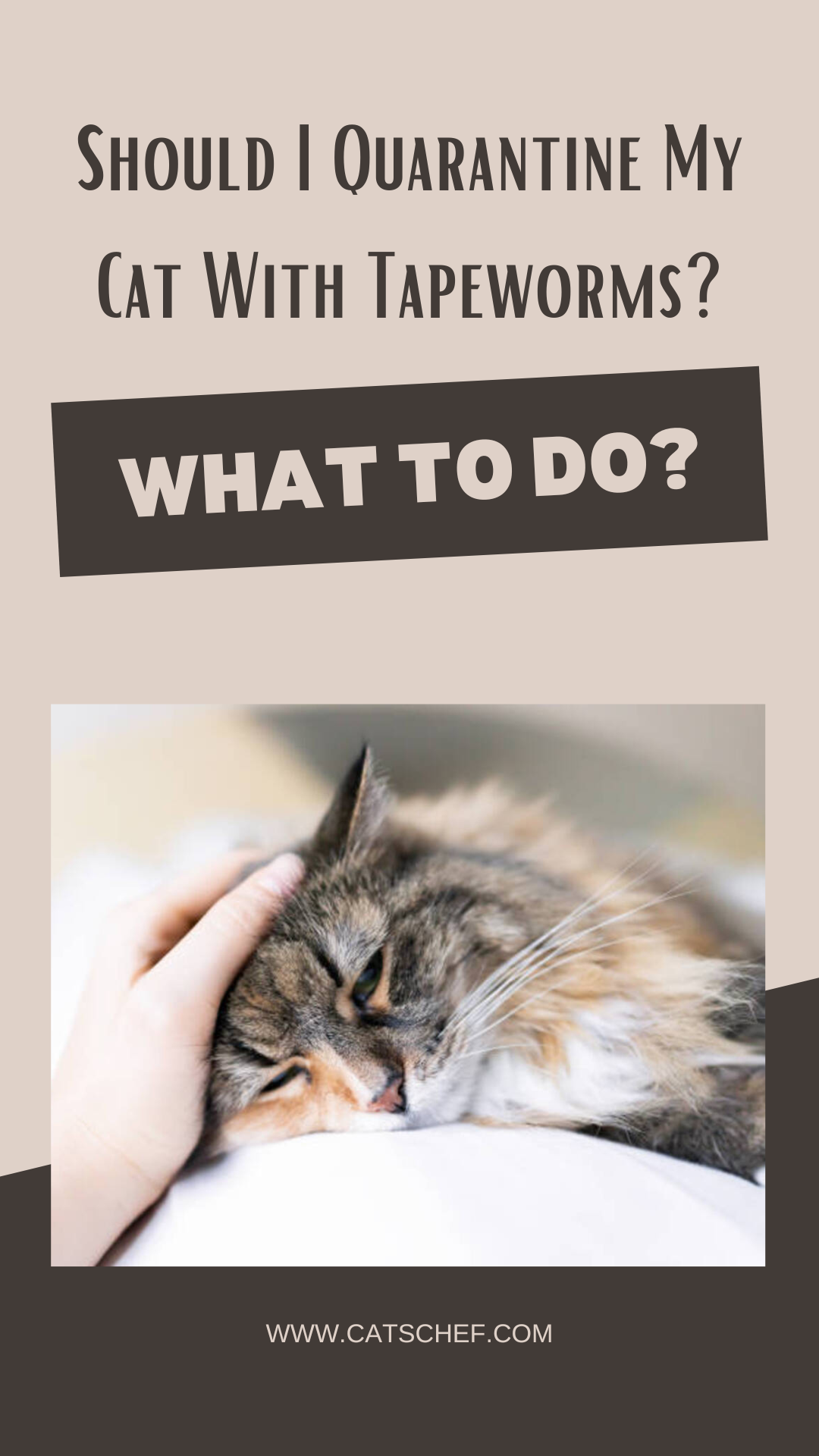📖 Table of Content:
“OMG! My little furball has tapeworms! What should I do now?!” If similar thoughts are currently plaguing you and you’re in a state of utter pawnic, asking “Should I quarantine my cat with tapeworms or what?” I’m happy to let you know you’ve come to the right place!
I think we can all agree that watching your cat suffer from any kind of unpleasant condition is one of the worst things for a devoted cat parent. We so desperately want to make their little furry lives as easy and as purrfect as possible, and tapeworms are clearly not on that agenda.
And even though we’re usually not the ones responsible for their infection and their fluffy curiosity takes all the blame, we can’t help but hold ourselves accountable for it. At least to some degree.
But, once our feline buddies get tapeworms, there’s no use crying over spilled milk. All we can do is help them cope with it and ensure they get the right treatment they need.
To see whether quarantine is a part of it, keep reading to find out.
Tapeworm in cats: What actually is it?
Before we answer your question, “Should I quarantine my cat with tapeworms?” let’s first go through the basic facts of this condition.
Tapeworm is a small white ribbon-like parasite that usually infects the small intestine in cats and other animals. It features a hook-shaped mouth with which it attaches itself to the insides of the small intestine where it then feeds, reproduces, and grows.
Once attached, tapeworms “suck out” all the nutrients from cats’ bodies, where they continue with their growth. On average, tapeworms grow up to between 4 and 30 inches, and they take around four weeks to grow to their biggest size.
As these parasites get bigger and bigger inside the feline small intestine, some pieces of them break off and get disposed of through poop. Those pieces are known as proglottids and are visible to the human eye.
Each proglottid is about the size of a grain of rice, and it usually contains around 20 tapeworm eggs. When the proglottids dry up due to air exposure, they start to disintegrate and release those eggs into the environment. Those freshly released eggs can often get ingested by another animal.
The most common tapeworm in cats is the one transmitted by fleas, Dipylidium caninum, commonly referred to as flea tapeworm, cucumber tapeworm, or double-pored tapeworm.
What causes tapeworms?
Dipylidium caninum, as well as several other tapeworm species such as Taenia taeniaeformis, for example, can frequently be found in the environment close to cats, such as water, soil, and animal feces.
Cats do not become infected with tapeworms by directly ingesting their eggs. Instead, they need a certain intermediary in order to become infected with this parasite. To put it plainly, for a cat to become infected, she must eat an infected animal.
Cats that live in an environment with a large number of fleas or those that hunt small animals such as rodents, squirrels, or mice are exposed to a higher risk of infection.
Although it can be concluded that outdoor cats are more prone to tapeworms (since they have to hunt in order to survive), indoor cats are not completely protected from this parasite.
This is especially true for cats who are part of multi-cat households or those who, as already mentioned, live in flea-infested areas. Many playful kitties love to catch flies that wander into their home. However, that seemingly innocent sport can have a not-so-happy ending.
What are the main symptoms of tapeworms in cats?
Believe it or not, since our feline friends are very private and love to keep their problems to themselves, it can be extremely difficult for you to determine whether your cat has tapeworms. That’s why regular vet checks are crucial!
Usually, a vet will determine or exclude the possibility of tapeworms in your cat through a fecal examination.
However, there are several symptoms that your kitty may display that signal she’s dealing with this annoying parasite. Some of them include:
- licking or biting her behind (this is usually due to itching, and it’s often manifested through bald spots or skin irritation)
- dragging her rectal area across the floor (with the intention to scratch her itchy behind)
- diarrhea
- vomiting
- bad fur condition
- fatigue and lethargy
- unbalanced appetite
- significant weight loss (this is because tapeworms are feeding on all the nutrients inside her body)
- hostility towards other people or animals
- tapeworm particles in her stool
So, should I quarantine my cat with tapeworms? And why?
I think we have all by now concluded how contagious tapeworms actually can be. So, the answer to your question is: Yes! You should definitely quarantine your cat with tapeworms. And here are three main reasons this step of precaution is extremely important:
1. You are reducing the risk of getting infected yourself
Although it is very rare, even humans can become infected with some form of tapeworm.
And yes, while you and your cat do not live the same lives, and you will hardly ever find yourself in a situation to eat animal excrement or an inflected flea, the chance of becoming infected, however small, is always there.
So, in order to protect your own health and the health of your family members and people closely related to you, it’s best to quarantine your infected feline. Rather not take the risk.
2. You are also minimizing the threat to other animals (if you have any)
The chances of you getting infected may be slim, but not so for other animals in your household. In fact, the chances of your other pets getting infected are extremely high (if your infected kitty is not quarantined, of course).
As highly contagious parasites, tapeworms can easily infect other cats and dogs. And if any of them gets infected, your struggle of deworming your house will surely become ten times more challenging.
3. And you are keeping the infection confined to one area
And finally, if you quarantine your cat and keep her in one place for a certain amount of time, you reduce the risk of the infection spreading to the rest of the house.
This makes it easier for you to take care of your cat and the spaces she’s temporarily sentenced to.
How long should your cat be in quarantine?
There is no exact and precise answer to this question as it varies from cat to cat.
Once your cat is diagnosed with tapeworms, you should immediately put her in quarantine. She should be confined to one place for at least three to four weeks, or even longer if you have other pets in your home. You should, of course, get them tested for tapeworms as well.
The period your cat stays in her quarantine also depends on your vet’s advice and her deworming medication.
How to quarantine your cat
I suggest you select a small room in your home and make it your fluff’s personal healing area for the next couple of weeks. It’s important to opt for a smaller space as it will be easier for you to keep it clean because the parasite exposure will be confined to one area.
That room should have all the things your cat might need: food and water bowls, a litter box, her bed, a cat tree, and other toys to keep her entertained, and basically anything she enjoys having around. All her stuff will help her cope with the reality of being a locked-up tower purrincess (minus the tower part).
You’ll have to ensure your cat’s things and the room she’s in are regularly cleaned to prevent tapeworm eggs from spreading and remaining in your home.
And most importantly, don’t be scared to visit your poor fluffball and show her some love. As mentioned before, the chances of you getting infected by this parasite are very small. So, as long as you’re careful enough, you’ll be free to cuddle your kitty, which she’ll greatly appreciate.
Just thoroughly wash your hands afterward!
How to treat tapeworms in cats
When it comes to treating tapeworms in cats, the best thing you can do for your fluff is to take her to the vet. They’ll perform a thorough examination, after which they will prescribe the appropriate deworming medication.
Deworming medication is basically an anti-parasitic agent which works on the principle of detaching tapeworms from a feline’s small intestine and removing it from the body through the feces. It can come in the form of a tablet or injection.
This type of medication usually takes around 24 hours to work. However, in most cases, the majority of cats are prescribed a second dosage of deworming medication three to four weeks after the initial treatment.
This is done to ensure that the infection is permanently gone and that all the worms are destroyed. As mentioned above, during all this time, your cat is supposed to be isolated.
What’s the risk of not treating tapeworms in cats?
If you don’t treat tapeworms in your cat, that infection can cause her a lot of trouble later. Your kitty can develop certain digestive problems, like obstructions in the digestive tract, and can become seriously malnourished.
In some severe cases, untreated tapeworms can result in cats losing a lot of blood from the places in their small intestines where tapeworms have attached themselves. The main sign of this is black and tar-like poop because of all the blood loss. This in turn can cause anemia, which in severe cases can lead to death.
Therefore, it’s crucial to be vigilant. Keep an eye on your kitty, and be cautious of any unusual behavior. And if in doubt, make sure to take her to the vet. You know what they say – better to be safe than sorry.






